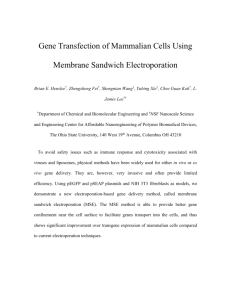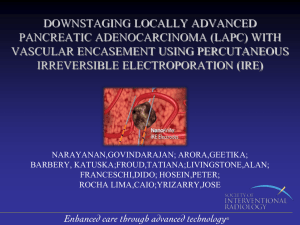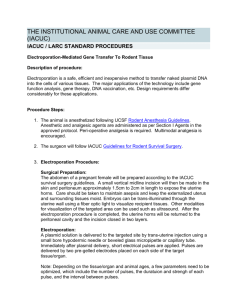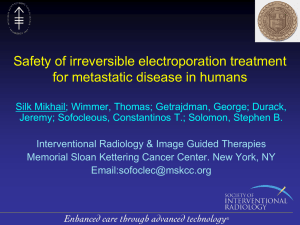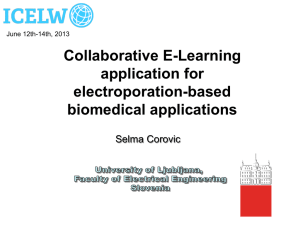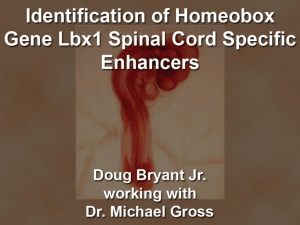Evaluation of Resistance as a Measure of
advertisement
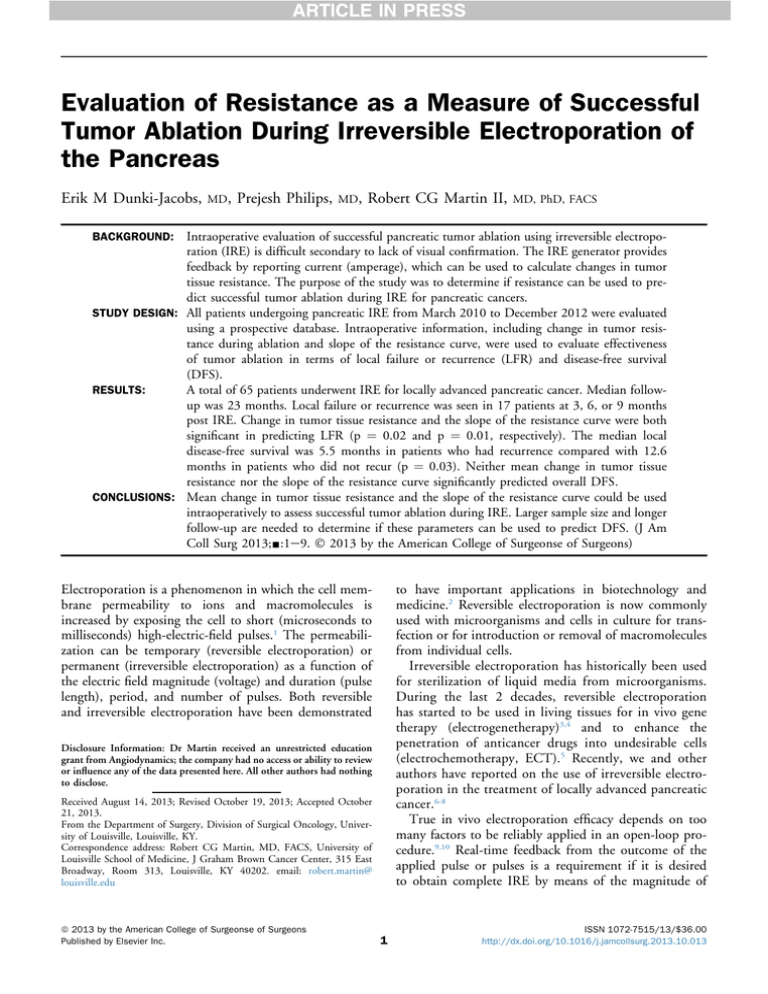
Evaluation of Resistance as a Measure of Successful Tumor Ablation During Irreversible Electroporation of the Pancreas Erik M Dunki-Jacobs, MD, Prejesh Philips, MD, Robert CG Martin II, MD, PhD, FACS Intraoperative evaluation of successful pancreatic tumor ablation using irreversible electroporation (IRE) is difficult secondary to lack of visual confirmation. The IRE generator provides feedback by reporting current (amperage), which can be used to calculate changes in tumor tissue resistance. The purpose of the study was to determine if resistance can be used to predict successful tumor ablation during IRE for pancreatic cancers. STUDY DESIGN: All patients undergoing pancreatic IRE from March 2010 to December 2012 were evaluated using a prospective database. Intraoperative information, including change in tumor resistance during ablation and slope of the resistance curve, were used to evaluate effectiveness of tumor ablation in terms of local failure or recurrence (LFR) and disease-free survival (DFS). RESULTS: A total of 65 patients underwent IRE for locally advanced pancreatic cancer. Median followup was 23 months. Local failure or recurrence was seen in 17 patients at 3, 6, or 9 months post IRE. Change in tumor tissue resistance and the slope of the resistance curve were both significant in predicting LFR (p ¼ 0.02 and p ¼ 0.01, respectively). The median local disease-free survival was 5.5 months in patients who had recurrence compared with 12.6 months in patients who did not recur (p ¼ 0.03). Neither mean change in tumor tissue resistance nor the slope of the resistance curve significantly predicted overall DFS. CONCLUSIONS: Mean change in tumor tissue resistance and the slope of the resistance curve could be used intraoperatively to assess successful tumor ablation during IRE. Larger sample size and longer follow-up are needed to determine if these parameters can be used to predict DFS. (J Am Coll Surg 2013;-:1e9. 2013 by the American College of Surgeonse of Surgeons) BACKGROUND: to have important applications in biotechnology and medicine.2 Reversible electroporation is now commonly used with microorganisms and cells in culture for transfection or for introduction or removal of macromolecules from individual cells. Irreversible electroporation has historically been used for sterilization of liquid media from microorganisms. During the last 2 decades, reversible electroporation has started to be used in living tissues for in vivo gene therapy (electrogenetherapy)3,4 and to enhance the penetration of anticancer drugs into undesirable cells (electrochemotherapy, ECT).5 Recently, we and other authors have reported on the use of irreversible electroporation in the treatment of locally advanced pancreatic cancer.6-8 True in vivo electroporation efficacy depends on too many factors to be reliably applied in an open-loop procedure.9,10 Real-time feedback from the outcome of the applied pulse or pulses is a requirement if it is desired to obtain complete IRE by means of the magnitude of Electroporation is a phenomenon in which the cell membrane permeability to ions and macromolecules is increased by exposing the cell to short (microseconds to milliseconds) high-electric-field pulses.1 The permeabilization can be temporary (reversible electroporation) or permanent (irreversible electroporation) as a function of the electric field magnitude (voltage) and duration (pulse length), period, and number of pulses. Both reversible and irreversible electroporation have been demonstrated Disclosure Information: Dr Martin received an unrestricted education grant from Angiodynamics; the company had no access or ability to review or influence any of the data presented here. All other authors had nothing to disclose. Received August 14, 2013; Revised October 19, 2013; Accepted October 21, 2013. From the Department of Surgery, Division of Surgical Oncology, University of Louisville, Louisville, KY. Correspondence address: Robert CG Martin, MD, FACS, University of Louisville School of Medicine, J Graham Brown Cancer Center, 315 East Broadway, Room 313, Louisville, KY 40202. email: robert.martin@ louisville.edu ª 2013 by the American College of Surgeonse of Surgeons Published by Elsevier Inc. 1 ISSN 1072-7515/13/$36.00 http://dx.doi.org/10.1016/j.jamcollsurg.2013.10.013 Dunki-Jacobs et al 2 Resistance Change in Pancreatic Electroporation Abbreviations and Acronyms DFS IRE LAP LFR RR ¼ ¼ ¼ ¼ ¼ disease-free survival irreversible electroporation locally advanced pancreatic cancer local failure or recurrence relative risk energy delivered and/or the number or duration of the pulses.11,12 A set of possible methods for assessing the effects of electroporation could be based on measurements of the passive electrical properties of the electroporationaffected cells or tissues.10,13-16 As a matter of fact, the electroporation phenomenon was first described in electrical terms.17,18 Measuring changes in electrical properties of cells has been proposed for determining the effectiveness of electroporation protocols in individual cells and in cell cultures.10,12 Similarly, changes in electrical properties were proposed for detecting electroporation in tissues,19 including creation of images of the electroporated tissue volumes by means of electrical impedance tomography.20 This study is part of a comprehensive effort to obtain definitive IRE endpoints at the time of energy delivery to better enhance efficacy and maintain safety through fully characterizing the changes in electrical properties of tissues with reversible and irreversible electroporation. In another previous study,21 the efficiency of different electroporation protocols for ablating tumors by IRE was assessed. Here we have used some of those protocols and we have compared the results in terms of impedance properties and of tissue damage. METHODS A prospective evaluation of patients undergoing irreversible electroporation for locally advanced pancreatic cancer (LAP) from December 2009 to November 2012 was performed, using an IRB-approved prospective data entry of a soft tissue ablation registry (http://www. ablationregistry.com) for patients treated with either an open surgical technique22 or a percutaneous approach.23,24 Locally advanced pancreatic cancer was defined as per the 7th edition of the American Joint Committee on Cancer (AJCC) staging system for pancreatic cancer, described as arterial encasement of either the celiac axis or the superior mesenteric artery, or both.25,26 Irreversible electroporation was not used on patients with borderline resectable lesions. We compared intraprocedural IRE therapy in patients who developed a local failure or electroporation failure or local recurrence against those patients who did not develop recurrence after each patient’s data were entered J Am Coll Surg prospectively at the time of initial IRE evaluation and IRE treatment. Local failure or electroporation failure was defined as the ability to bracket the entire tumor with appropriate needles and deliver at least 90 pulses to the target lesions and without 3-month imaging confirmation of ablation success. Local recurrence was defined as above, but with 3-month confirmation and then subsequent recurrence of the target lesion. Comparisons were made between the groups in terms of patient demographics, short-term outcomes, and overall (OS) and disease-free (DFS) survivals. Baseline comorbidities were assessed using the Charlson Comorbidity Index. Surgical complications were graded according to our standard scale, which has been previously published.27,28 All statistical analyses were performed using SAS version 9.3 (SAS Institute), and p values <0.05 were considered significant. Surgical and percutaneous electroporation technique The surgical decision making has been described previously,27 but in short, the ultimate decision to perform pancreatic resection with IRE or IRE alone was at the surgeon’s discretion based on intraoperative assessment, patient comorbidities, previous therapy, and patient desire.27 The technique for IRE alone has been recently published describing needle placement and IRE energy delivery.22 The surgical technique was carried out as described by Martin and colleagues27 for pancreatic head lesions and by Makary and associates29 for pancreatic body-medial tail lesions. The use of resection and IRE in these unique cases was performed to treat suspected positive margins and was not performed when gross residual disease would be left behind. The percutaneous IRE approach to LAP was up to the treating physician and the multidisciplinary team to which the patient was referred for evaluation. The percutaneous IRE approach for LAP has been extensively described by both Bagla and colleagues24 and Narayanan and associates.23 However, in short, using general anesthesia commonly 2 to 3 15-cm monopolar probes in 2 separate sessions is one of the established techniques to avoid using more than 4 probes. The probes are commonly placed into the central and lateral aspect of the tumor under ultrasound guidance in a square configuration, with average probe spacing of 1.8 cm.24 Computed tomography imaging with contrast medium was performed to evaluate needle position relative to vessels and measure interprobe distance. All probes had 1 to 1.5 cm of electrode exposure, and in certain instances, 1 or more probes may have had to be placed by using a Vol. -, No. -, - 2013 Dunki-Jacobs et al transhepatic approach. Certain circumstances required a 22-gauge spinal needle to be placed under ultrasound guidance into the gastrohepatic space to perform hydrodissection with sterile water. One of the primary reasons for either the open or the percutaneous approached was decided on by the end-user of the IRE device based on each institution’s technical skill and bias of IRE delivery. All postoperative complications out to 90 days were monitored and graded prospectively according to a previously published 5-point scale.30,31 The delivery of IRE was performed via the NanoKnife system (Angiodynamics), as described in our previous manuscript of IRE in the porcine pancreas6 and patients with LAP.27 The NanoKnife system records the voltage output and current output of each pulse. The system has an ammeter built into the circuit board, which measures the current draw. Resistance is calculated by dividing the voltage by the current using Ohm’s Law: V ¼ IR or R ¼ V/I. Follow-up imaging was performed at the time of discharge or within 2 weeks of IRE therapy for safety Resistance Change in Pancreatic Electroporation 3 evaluation, and then at 3-month intervals. Ablation success and recurrence were defined as per Response Evaluation Criteria In Solid Tumors (RECIST) criteria, with either persistent viable tumor as defined by dynamic imaging in comparison to pre-IRE scan, or persistent hypermetabolic activity if hypermetabolic on pre-IRE scan or tissue diagnosis (Fig. 1). Ablation success was defined as the ability to deliver the planned therapy in the operating room and within 3 months to have no evidence of residual tumor as described above. The method of evaluating incomplete electroporation or local recurrence is the combination use of cross-sectional imaging, either a CT scan or MRI, with or without PET scanning based on the ability to obtain a preoperative PET scan and whether the primary lesion in question had PET activity (defined as an standardized uptake value > 8 before IRE). Those imaging modalities, with a rising CA 19-9 value as well as clinical presentation (return of back pain similar to pre-IRE, worsening gastric emptying, or jaundice) were all used to determine incomplete electroporation or local recurrence. All images were read by dedicated body imagers, none of whom were IRE proceduralists. Post-IRE imaging of the pancreas is Figure 1. (A) Preoperative CT image: patient 1, pancreatic adenocarcinoma is demonstrated (white arrow) with encasement of the superior mesenteric artery. (B) Postoperative CT image (6 months after irreversible electroporation): patient 1, an “amorphous” non-mass-like soft tissue density (arrow) is noted in place of the mass. This density persists for greater than 12 months. (C) First image (preoperative): patient 2, demonstrates a pancreatic mass (arrow) encasing the superior mesenteric vein. (D) Second image (2 weeks after irreversible electroporation): patient 2, the “amorphous” density (arrow) replacing the mass is somewhat heterogeneous compared with the previous example. (E) Third image (3 months after irreversible electroporation): patient 2, development of a new bulky mass (arrow) consistent with recurrence. 4 Dunki-Jacobs et al J Am Coll Surg Resistance Change in Pancreatic Electroporation challenging given the acute inflammatory changes seen from postoperative days 1 through 10, as well as the soft tissue inflammation that occurs during the apoptotic process, as described by Bower and colleagues, which persists out to 6 to 8 weeks postablation.6,27 So involvement of a dedicated body imager is recommended when initiating a pancreatic IRE ablation program. RESULTS A total of 65 patients were included in this prospective observational review of the use of IRE as definitive therapy in the treatment of patients with LAP (Table 1). A majority of patients treated had pancreatic head lesions, with a median overall lesion size of 3.5 cm at maximum diameter. The decision on pre-IRE therapy was not dictated by the IRE treating physician and was at the discretion of the referring physician or center, explaining the differences in the groups. Because the application of IRE requires general endotracheal anesthesia, a majority of patients had good-to-normal performance status without any significant comorbidities. In comparing the 17 patients who developed either incomplete electroporation or local recurrence vs 48 patients who did not have local recurrence, they were similar in regard to lesion location, lesion maximum size, comorbidity index, andprevious use of chemotherapy, with a slight increase in incidence of chemoradiation therapy in the local recurrence patient subset. In evaluating both groups for median time to diagnosis and the overall irreversible electroporation approach, there was a shorter time from diagnosis to electroporation treatment in the incomplete electroporation or local recurrence group, with a significantly greater incidence of the percutaneous approach also in the incomplete electroporation or local recurrence group. The concurrent and subsequent operations that occurred simultaneously with IRE were similar in both groups, with similarities also in regard to the number of IRE probes used (Table 2). The percutaneous approach is commonly performed in an anterior-toposterior type of needle trajectory, which explains why there is a difference in the incomplete electroporation or local recurrence group when compared with the open group, in which the needle is commonly placed in a caudal-to-cranial fashion. The overall procedure time, length of hospital stay, and adverse events were also similar in both groups (Table 3). The use of adjuvant therapy after IRE treatment was similar in both groups, with 65% (n ¼ 11) in the recurrent group and 74% (n ¼ 36 patients) in the nonrecurrent group. Table 1. Characteristics of 65 Locally Advanced Pancreatic Cancer Patients Treated with Irreversible Electroporation* Characteristics (n ¼ 65) Location, % Head Body/neck Lesion size, cm (range) Axial Anterior - posterior Caudal to cranial Performance status, % 100 90 80 Charleston Comorbidity Index, median (IQR) Prior chemotherapy, n Gemzar FOLFOX FOLFIRI Oxaliplatin Avastin Cisplatin Taxol FOLFIRINOX Abraxane Tarceva Other Prior radiation therapy, % 5FU and radiation Gemzar and radiation Local recurrence No recurrence p (n ¼ 17) (n ¼ 48) Value 68 32 65 35 0.11 4.1 (1.9e5.0) 3.1 (1.1e5.1) 2.9 (1.5e5.0) 3.3 (1e5.5) 2.8 (1e4.7) 2.7 (1e4.9) 0.13 65 20 15 80 10 10 0.07 4 (1) 4 (1) 0.1 12 3 1 2 1 5 2 4 2 7 16 20 3 0 2 1 3 1 10 4 6 20 54 16 38 17 0.09 0.06 *Seventeen patients with local electroporation failures or recurrence vs 48 patients without local electroporation recurrence. IQR, interquartile range. The recurrences in the 17 patients that occurred did so fairly early after electroporation, with 7 at 3 months and 10 occurring at 6 months. When we look at the mean change in ohms we can see that there is a significantly smaller change in the recurrence patient subset, with a change of baseline to IRE completion of only 16.2 ohms. This is significantly less than in the subset of 48 patients who did not develop recurrence, which had a change of 28.2 ohms (Table 4) (Fig. 2). Given the fact that the current IRE generator does not provide changes in resistance or changes in ohms in the generator, this change of 28.2 ohms in resistance can be correlated to an approximate change in amperage draw of 12 to 15 amps. Vol. -, No. -, - 2013 Dunki-Jacobs et al Resistance Change in Pancreatic Electroporation 5 Table 2. Operative and Ablative Characteristics of Patients with Locally Advanced Pancreatic Cancer Treated with Irreversible Electroporation Characteristics Median time from diagnosis to electroporation, mo (range) Approach, n Open, supine midline Laparoscopic Percutaneous Pancreatic operations, n Whipple Subtotal Pancreatectomy Other operations, n Hepticojejunostomy Gastrojejunostomy Partial gastrectomy* Celiac plexus block Other No. of IRE probes used Bipolar Monopolar No. of probes (range) Direction of IRE probes, n Anterior to posterior, Caudal to cranial Success of IRE delivery, % Total IRE delivery time, min (range) Total procedure times, min (range) Length of stay, d (range) Adverse events Follow-up local recurrence (median follow-up 12 mo), mo 3 6 9 12 Local recurrence (n ¼ 17) No recurrence (n ¼ 48) 2.1 (1e12.1) 6.1 (4e32.1) 5 0 12 48 0 0 0 3 8 13 0 3 0 0 3 12 20 3 10 27 3 patients 14 patients 4 (3e6) 6 patients 42 patients 4 (3e6) 14 3 100 19 (10e189) 185 (40e500) 4 (1e28) 13 patients had 24 complications 1 47 100 43 (2e189) 190 (40e500) 6 (5e58) 24 patients had 67 complications 7 10 NA NA 0 0 0 0 *Considered additional organ when performed in conjunction with distal pancreatectomy. IRE, irreversible electroporation. Median follow-up was 23 months. Recurrence was seen in 17 patients at 3, 6, or 9 months post IRE. Change in tumor tissue resistance and the slope of the resistance curve were both significant in predicting LFR (p ¼ 0.02 and p ¼ 0.01 respectively) on univariate analysis (Fig. 3). The median local DFS was 5.5 months in patients who suffered recurrence compared with 12.6 months in patients who did not recur (p ¼ 0.03). On multivariate analysis to evaluate predictors of recurrence, the lack of change in resistance (relative risk [RR] 2.5, 95% CI 1.4 to 5.6, p ¼ 0.002) was the single greatest predictor of local recurrence and failure when evaluating for time to diagnosis (not significant), lesion size (RR 1.6, 95% CI 1.1 to 7.8, p ¼ 0.02), patient comorbidities (not significant), number of probes (RR 1.4, 95% 0.8 to 4.5, p ¼ 0.09), and overall total IRE delivery time. Only change in resistance was the single greatest factor in predicting local recurrence, regardless of adjuvant therapy that was delivered. Neither mean change in tumor tissue resistance nor the slope of the resistance curve significantly predicted overall DFS. DISCUSSION The incidence of locally advanced stage III pancreatic cancer continues to remain at 30% to 35% of initial pancreatic cancer diagnoses. Recently, the biologic aggressiveness and the natural history of this stage of cancer 6 Dunki-Jacobs et al Resistance Change in Pancreatic Electroporation Table 3. Adverse Events in Patients with Locally Advanced Pancreatic Cancer Treated with Irreversible Electroporation or with Standard Chemotherapy and/or Radiation Alone* Type of complication Local recurrence (n ¼ 17) n Grade No local recurrence (n ¼ 48) n Grade Ileus Bile leak Portal vein thrombosis/ graft failure Deep venous thrombosis Pulmonary Renal failure Ascites Wound infection Dehydration/ failure to thrive/ nausea Bleeding Liver insufficiency Pancreatic leak Other 3 0 2 3 4 2 3 2 4 1 3 0 16 2 2 3 2 3 0 2 3 4 2 1 0 10 2 NA 3e4 1e2 2,3 1e3 1e3 1,2 1e4 1 2,3 NA 1e4 2 3 2,5 2 2,3 NA 1,3 1e2 1e3 2,4 2 NA 1e3 *Adverse event capture did not start in the standard arm until after 4 months of therapy to better compare it with the irreversible electroporation group. have been questioned and are believed to have a different biology when compared with metastatic disease. The biology of disease of stage III pancreatic cancer was further confirmed when recent autopsy series of patients with pancreatic cancer identified 30% who died of locally destructive disease without evidence of progression at distant sites.32 Recent reports from our institution and others demonstrated the safety and efficacy of the use of IRE in the multidisciplinary management of LAP cancer.23,27,28 However, the use of IRE has been plagued by the lack of true clinical trials as well as better defined intraelectroporation endpoints. Given that IRE’s method of action is a nonthermal-based cell membrane porosity, attempting to use the historical thermal ablation endpoints (time and temperature) is not feasible. Similarly, attempting to use intraprocedural imaging with either ultrasound or CT for pancreatic IRE is also not feasible because the edema and artifactual distortion are such that any attempt to image a defined IRE defect is not possible. Table 4. Multivariate Analysis of Predictor of Local Recurrence after Irreversible Electroporation of Locally Advanced Pancreatic Adenocarcinoma Variable Mean change in resistance (SE) Mean slope of resistance (SE) Local recurrence No local recurrence p (n ¼ 17) (n ¼ 48) Value 16.2 (1.17) 28.2 (0.67) 0.02 0.16 (0.03) 0.27 (0.02) 0.01 J Am Coll Surg Evaluating resistance as a possible clinical endpoint demands the understanding of Ohms Law. Ohm’s Law is derived from 3 mathematical variables that show the relationship between electric voltage, current, and resistance. Voltage, current, and resistance directly interact in Ohm’s Law. A change in any one of them affects the third. In the following equations, V is voltage measured in volts, I is current measured in amperes (the term current refers to the quantity, volume, or intensity of electrical flow, as opposed to voltage, which refers to the force or “pressure” causing the current flow), and R is resistance measured in ohms: R ¼ V/I (Resistance ¼ Voltage divided by Current). Knowing any 2 of the values of a circuit, one can determine the third, using Ohm’s Law. Given that with the current IRE systems, the voltage is set and does not change, the current is delivered in amperes, which are measured by the device (Fig. 1), so the resistance can be calculated. The initial work on change in resistance with electroporation was reported by Ivorra and Rubinsky.14 They reported that a simpler electrical model of biologic cell impedance can be used to qualitatively understand the effects of electroporation on the tissues’ electrical properties. A resistance, which in this case represents the extracellular medium, is in parallel with a capacitance accounting for the cell membrane in series with resistance represented by the intracellular medium. When electroporation is achieved, then the membrane capacitance is changed by a change in membrane resistance. Each pulse causes an immediate increase in conductivity (change in resistance through cell membrane porosity) that is followed by a slow recovery toward the original conductivity value. Such recovery becomes slower with time and additional pulses. This has been reported by DeBruin and Krassowska,33 who found that there is an increase in the number of pores over time, after pulse delivery occurs in an exponential function. However, given the heterogeneity of tissues and in particular, of cancers, the cell membrane porosity induced by electroporation pulses could manifest a wide range of resealing time constants. This range can be overcome with the accumulative effects of multiple pulses. That is, each pulse increases the conductivity of the tumor. However, it is also clearly observable that the stepwise increase in conductivity is smaller pulse after pulse, which is plausible when one considers that the electroporation phenomenon depends on the transmembrane voltage and the transmembrane voltage induced by an external electric field depends on the conductivity of the membrane. In other words, as the membrane conductance increases due to permeabilization, it is more difficult to achieve the required Vol. -, No. -, - 2013 Dunki-Jacobs et al Resistance Change in Pancreatic Electroporation 7 Figure 2. (A) An example of current draw (top in amps) and then change in resistance (bottom in ohms) from an incomplete ablation based on the lack of adequate change in ohms. (B) An example of current draw (top in amps) and then change in resistance (bottom in ohms) from a complete ablation based on the adequate change in ohms. transmembrane voltage for further permeabilization. Hence, pulse repetitions not only increase permeabilization but also make it more stable and therefore irreversible. This has been demonstrated previously when long, or multiple, pores increase the radius of previously created pores, making them more stable33 as well as demonstrating that multiple pores increase the probability for the formation of the so called long-lived pores.34 8 Dunki-Jacobs et al Resistance Change in Pancreatic Electroporation J Am Coll Surg Figure 3. (A) One way analysis of mean change slope by recurrence. (B) One way analysis of mean change resistance by recurrence. The safest and simplest way to create more stable pores with the current IRE technology is to increase the total number of pulses delivered between a probe pair. As we have previously reported, this is best achieved by creating energy settings that allowed for the initial 20 pulses to be delivered at approximately 25 amperes from the machine.22 This initial current draw will allow for multiple pulses (usually 90 to 220 pulses) to be delivered across all probe pairs and also for for tissue conductivity to change. This leads to an adequate rise in the amperes drawn from the machine to approximately 38 to 42 amperes, which avoids any high current and any critical thermal thresholds. These steps are critical given the high variability that exists in LAP cancer patients, based on the use of radiation therapy, presence or absence of a metal stent, history of pancreatitis, and other factors that affect peripancreatic stroma and tissue. Our experience here was that patients treated with pre-IRE radiation therapy with a metal stent have far more fibrotic tissue and require acute attention to both the 20-pulse test/tissue assessment as well as through the entire energy delivery. CONCLUSIONS In conclusion, change in resistance as measured by change in tumor tissue resistance and the slope of the resistance curve should be used intraoperatively to assess successful tumor ablation during IRE. The current surrogate marker of that change is a change in amperes of approximately 12 to 15 from the initial 20 pulses delivered. A high degree of intraprocedural vigilance is required by the end user to ensure that this change occurs to achieve optimal efficacy, as well as to ensure that a high current does not develop in order to maintain the current standard of safety. This vigilance and understanding of the tissue to be treated, as well as the established learning curve with the use of this device, are key to ensuring both safety and efficacy.35 Author Contributions Study conception and design: Dunki-Jacobs, Philips, Martin Acquisition of data: Dunki-Jacobs, Philips, Martin Analysis and interpretation of data: Dunki-Jacobs, Philips, Martin Drafting of manuscript: Dunki-Jacobs, Philips, Martin Critical revision: Dunki-Jacobs, Philips, Martin REFERENCES 1. Neumann E, Schaefer-Ridder M, Wang Y, Hofschneider PH. Gene transfer into mouse lyoma cells by electroporation in high electric fields. Embo J 1982;1:841e845. 2. Mir LM. Therapeutic perspectives of in vivo cell electropermeabilization. Bioelectrochemistry 2001;53:1e10. 3. Dean DA. Nonviral gene transfer to skeletal, smooth, and cardiac muscle in living animals. Am J Physiol Cell Physiol 2005; 289:C233eC245. 4. Jaroszeski MJ, Gilbert R, Nicolau C, Heller R. Delivery of genes in vivo using pulsed electric fields. Methods Mol Med 2000;37:173e186. 5. Gothelf A, Mir LM, Gehl J. Electrochemotherapy: results of cancer treatment using enhanced delivery of bleomycin by electroporation. Cancer Treat Rev 2003;29:371e387. 6. Bower M, Sherwood L, Li Y, Martin R. Irreversible electroporation of the pancreas: definitive local therapy without systemic effects. J Surg Oncol 2011;104:22e28. 7. Charpentier KP, Wolf F, Noble L, et al. Irreversible electroporation of the liver and liver hilum in swine. HPB: the official journal of the International Hepato Pancreato Biliary Association 2011;13:168e173. 8. Charpentier KP, Wolf F, Noble L, et al. Irreversible electroporation of the pancreas in swine: a pilot study. HPB: the official journal of the International Hepato Pancreato Biliary Association 2010;12:348e351. 9. Cegovnik U, Novakovic S. Setting optimal parameters for in vitro electrotransfection of B16F1, SA1, LPB, SCK, L929 and CHO cells using predefined exponentially decaying electric pulses. Bioelectrochemistry 2004;62: 73e82. 10. Pavlin M, Kanduser M, Rebersek M, et al. Effect of cell electroporation on the conductivity of a cell suspension. Biophys J 2005;88:4378e4390. Vol. -, No. -, - 2013 Dunki-Jacobs et al 11. Cukjati D, Batiuskaite D, Andre F, et al. Real time electroporation control for accurate and safe in vivo non-viral gene therapy. Bioelectrochemistry 2007;70:501e507. 12. Glahder J, Norrild B, Persson MB, Persson BR. Transfection of HeLa-cells with pEGFP plasmid by impedance powerassisted electroporation. Biotechnol Bioeng 2005;92: 267e276. 13. Ivorra A, Rubinsky B. Electric field modulation in tissue electroporation with electrolytic and non-electrolytic additives. Bioelectrochemistry 2007;70:551e560. 14. Ivorra A, Rubinsky B. In vivo electrical impedance measurements during and after electroporation of rat liver. Bioelectrochemistry 2007;70:287e295. 15. Grafstrom G, Engstrom P, Salford LG, Persson BR. 99mTcDTPA uptake and electrical impedance measurements in verification of in vivo electropermeabilization efficiency in rat muscle. Cancer Biother Radiopharm 2006;21:623e635. 16. Kinosita K Jr, Tsong TY. Voltage-induced conductance in human erythrocyte membranes. Biochim Biophys Acta 1979; 554:479e497. 17. Schmidt H, Stampfli R. [Depolarization by calcium deficiency and its relation to potassium concentration]. Helv Physiol Pharmacol Acta 1957;15:200e211. 18. Stampfli R, Willi M. Membrane potential of a Ranvier node measured after electrical destruction of its membrane. Experientia 1957;13:297e298. 19. Dev SB, Dhar D, Krassowska W. Electric field of a six-needle array electrode used in drug and DNA delivery in vivo: analytical versus numerical solution. IEEE Trans Biomed Eng 2003; 50:1296e1300. 20. Davalos RV, Rubinsky B, Otten DM. A feasibility study for electrical impedance tomography as a means to monitor tissue electroporation for molecular medicine. IEEE Trans Biomed Eng 2002;49:400e403. 21. Al-Sakere B, Andre F, Bernat C, et al. Tumor ablation with irreversible electroporation. PloS one 2007;2:e1135. 22. Martin RC. Irreversible eectroporation of locally advanced pancreatic head adenocarcinoma. J Gastrointest Surg: official journal of the Society for Surgery of the Alimentary Tract 2013;17:1850e1856. 23. Narayanan G, Hosein PJ, Arora G, et al. Percutaneous irreversible electroporation for downstaging and control of unresectable pancreatic adenocarcinoma. J Vasc Interv Radiol 2012;23:1613e1621. Resistance Change in Pancreatic Electroporation 9 24. Bagla S, Papadouris D. Percutaneous irreversible electroporation of surgically unresectable pancreatic cancer: a case report. J Vasc Interv Radiol 2012;23:142e145. 25. Callery MP, Chang KJ, Fishman EK, et al. Pretreatment assessment of resectable and borderline resectable pancreatic cancer: expert consensus statement. Ann Surg Oncol 2009; 16:1727e1733. 26. Varadhachary GR, Tamm EP, Abbruzzese JL, et al. Borderline resectable pancreatic cancer: definitions, management, and role of preoperative therapy. Ann Surg Oncol 2006;13: 1035e1046. 27. Martin RC 2nd, McFarland K, Ellis S, Velanovich V. Irreversible electroporation therapy in the management of locally advanced pancreatic adenocarcinoma. J Am Coll Surg 2012; 215:361e369. 28. Martin RC 2nd, McFarland K, Ellis S, Velanovich V. Irreversible electroporation in locally advanced pancreatic cancer: potential improved overall survival. Ann Surg Oncol 2012 November 6. [Epub ahead of print] 29. Makary MA, Fishman EK, Cameron JL. Resection of the celiac axis for invasive pancreatic cancer. J Gastrointest Surg 2005;9:503e507. 30. Martin RC, Scoggins CR, Egnatashvili V, et al. Arterial and venous resection for pancreatic adenocarcinoma: operative and long-term outcomes. Arch Surg 2009;144:154e159. 31. Anderson RJ, Dunki-Jacobs E, Callender GG, et al. Clinical evaluation of somatostatin use in pancreatic resections: Clinical efficacy or limited benefit? Surgery 2013;154:755e760. 32. Iacobuzio-Donahue CA, Fu B, Yachida S, et al. DPC4 gene status of the primary carcinoma correlates with patterns of failure in patients with pancreatic cancer. J Clin Oncol: official journal of the American Society of Clinical Oncology 2009; 27:1806e1813. 33. DeBruin KA, Krassowska W. Modeling electroporation in a single cell. I. Effects Of field strength and rest potential. Biophys J 1999;77:1213e1224. 34. Pavlin M, Miklavcic D. Theoretical and experimental analysis of conductivity, ion diffusion and molecular transport during cell electroporationerelation between short-lived and longlived pores. Bioelectrochemistry 2008;74:38e46. 35. Philips P, Hays D, Martin RCG. Irreversible electroporation ablation (IRE) of unresectable soft tissue tumors: learning curve evaluation in the first 150 patients treated. PloS one 2013;8:e76260.
